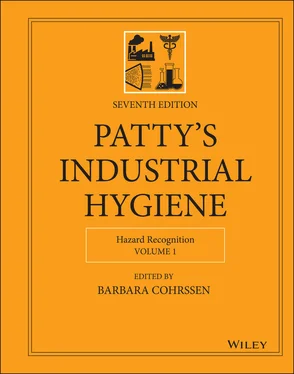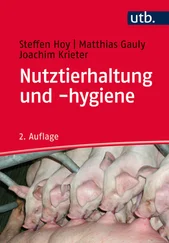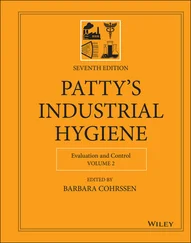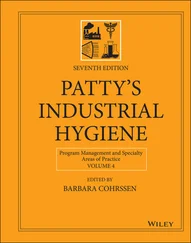Bureau of Mines, Technical Paper No. 248, 1921.
Part I INTRODUCTION TO INDUSTRIAL HYGIENE
OCCUPATIONAL AND INDUSTRIAL HYGIENE AS A PROFESSION: YESTERDAY, TODAY, AND TOMORROW
BARBARA J. DAWSON MS CIH CSP FAIHA, KYLE B. DOTSON CIH CSP BCEE, FAYE GRIMSLEY PH.D. CIH MSPH, THOMAS GRUMBLES CIH FAIHA, ZACK MANSDORF PH.D. CIH CSP QEP FAIHA, DAVID ROSKELLEY MSPH CIH CSP FAIHA, JENNIFER SAHMEL MPH CIH CSP FAIHA, NOEL TRESIDER AM FAIOH, AND CANDACE TSAI SCD CIH
1 INTRODUCTION: THE RATIONALE FOR INDUSTRIAL HYGIENE PRACTICE
In the first edition of Patty's Industrial Hygiene and Toxicology in 1948, Mr. Frank A. Patty defined industrial hygiene as: “the concept of anticipating and recognizing potentially harmful situations and applying engineering control measures before serious injury results.” (1, p. v). The rationale for industrial hygiene has continued to evolve since that time. Seventy years later, in this now Seventh Edition of the original Patty's textbook, the profession is still concerned with the same worthy goals described by Mr. Patty but has expanded the rationale for the profession to encompass a number of important additional aspects of this practice. Some examples of these aspects include improved approaches to exposure and risk assessment for evaluating and characterizing workplace stressors. In addition, the practice of industrial hygiene has expanded the list of agents considered to be stressors to encompass not only chemical, physical, and biological stressors, but also ergonomic, physiological, psychological, and behavioral stressors. And finally, improved recognition of the interaction and effects of workplace health on family, community, and public health has become an increasing focus of the industrial hygiene profession. These new elements have manifested through management approaches, product stewardship, and programs such as, in the United States, the National Institute for Occupational Safety and Health's Total Worker Health ®(TWH) program. Both generalists and specialists within the profession are working to address these enhanced and worthy goals, and the rationale for industrial hygiene practice continues to evolve. This chapter presents an analysis of this evolution and also provides an updated working definition of industrial hygiene as well as a discussion of the current and future rationale and practice of industrial hygiene.
The terms industrial hygiene and occupational hygiene are used to describe essentially the same profession. Industrial hygiene was the term used in the United States (US) when the profession first started, however, throughout most of the rest of the world the term Occupational Hygiene is used. For the purposes of this chapter, the terms industrial hygiene and occupational hygiene may be considered interchangeable.
2 HISTORICAL PERSPECTIVE AND EVOLUTION OF THE RATIONALE OF INDUSTRIAL HYGIENE PRACTICE
The aim of this chapter section is not to document or present chronologically the major past contributors to worker health and their relevant works, or the events and episodes that gave urgency to the development of industrial hygiene as a science and a profession. Rather, the purpose of this section of this chapter is to place in perspective the history and evolution of industrial hygiene from the early works of pioneers in the field through the major periods of change in the last 100 years, which led to the contemporary practice of industrial and occupational hygiene and the current rationale for practice.
The field of industrial hygiene has its roots in the profession of public health. Merriam‐Webster's Dictionary defines public health as “the art and science dealing with the protection and improvement of community health by organized community effort and including preventive medicine and sanitary and social science.” The term public health was first used early in the seventeenth century. The term industrial hygiene to identify a profession or field of work largely originated in the twentieth century. One must go further back in history, however, to find the root origins of the terminology. The term “industry,” with a dictionary meaning, “systematic labor for some useful purpose or the creation of something of value,” has its English origin in the fifteenth century. The word “hygiene” goes back to much earlier times. Hygieia, a daughter of Asklepios who was god of medicine in Greek mythology, was responsible for the preservation of health and prevention of disease. Thus, the roots of the term industrial hygiene (like occupational hygiene) mean preservation of health and prevention of disease among people engaged in systematic labor for some useful purpose or the creation of something of value .
In the public health context, then, the purpose of industrial hygiene is to protect the health of communities of workers. The modern definition of industrial hygiene includes protection of the health of persons living around a place of work from hazards that may arise from that place of work, and in more recent decades, the environment of the community at large.
Occupational diseases and the deaths of workers have been documented for more than 2000 years. In the fourth century BCE, lead toxicity was recognized and recorded by Hippocrates. In the first century CE, Pliny the Elder, a Roman scholar, recognized the dangers of dealing with zinc and sulfur and described a bladder derived mask for workers to protect them against dust and lead fumes. In the second century, Galen, a Greek physician, recognized the dangers of acid mists to copper miners. The association between work and disease was recognized, but knowledge of the causative agent, including the toxicity of materials, the hazards of physical and biological agents, and the ergonomic stressors encountered in industry did not exist in those very early times. With few exceptions, the earliest attention given to worker health was in applying the knowledge at hand, which was primarily the recognition and treatment of illnesses associated with a job.
During this early period, workplace exposures were often significant, leading to a high prevalence of diseases and excess deaths. There were no major advances until 1473 when Ulrich Ellenborg published a pamphlet on occupational disease and gave instruction on hygiene. In 1538, Paracelsus, a Swiss alchemist, published considerable material on the toxicology of smelting metals (some of which was later determined to be incorrect) but his work led to the observation, “No substance is a poison by itself, it is the dose that makes a substance a poison,” (2) which formed the basis for the science of toxicology. The first scientific approach to occupational health was by Agricola in Latin in 1556 (3) and more than a century later, in 1700, Bernardo Ramazzini, an Italian physician, published a treatise on occupational disease, De Morbis Artificum , and coined the phrase still asked by occupational physicians, “Of what trade are you?” (4)
Although diseases caused by conditions of work have been recognized and treated for many hundreds of years, it was not until around the turn of the twentieth century that major efforts began to be directed toward what we now think of as fundamental industrial hygiene – the anticipation, recognition, evaluation, and control of workplace health hazards to prevent occupational disease. Scientists and practitioners, including engineers, chemists, and physicists, began to apply their knowledge and skills toward the development of methods and procedures for identifying, measuring, and controlling exposures to harmful airborne dusts and other chemical agents in workplaces. At that time, there were no consistent procedures for carrying out these activities.
Читать дальше












